The musicians of the Thar Desert in India have maintained a continuous musical lineage for well over 1,000 years. But the sands and sounds of this arid land are shifting. New Zealand musician and sound engineer Daniel Beban visited to find out more.

Hindal Khan from Dhantal village plays the kamaicha Photo: Daniel Beban
People born into the Rajasthani musician castes, Manganiyar, Langa, Kalbelia and several others, are trained from a young age in the instruments and songs particular to their caste.
These low-caste, professional musicians have relied on a system of patronage from higher-caste patron families (jajman) that supply the food, land, livestock and money they need to survive.
In return they perform for their patrons’ ceremonies of births, weddings, funerals and other life-cycle rituals.
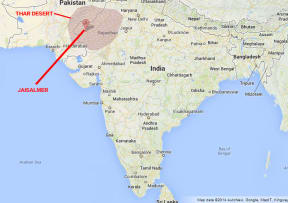
Map showing the Thar Desert region Photo: wikicommons
But the sands and sound of the Thar Desert are shifting. The global economy has arrived in the desert in recent decades, bringing with it water, electricity, large-scale agriculture and investment.
The patron families of the desert villages, many of whom were subsistence farmers, are leaving their land and moving to centres of industry and commerce to find new opportunities.
This, in turn, is forcing the musicians to leave their villages and look for work in the cities. Some perform for tourists at hotels, others work in unrelated trades, as truck drivers and laborers.
A lucky few tour the world, performing at international festivals as acclaimed Indian folk musicians.
This programme looks at the rich, ancient musical tradition of the Thar Desert and the challenges it is facing adapting to the modern world.
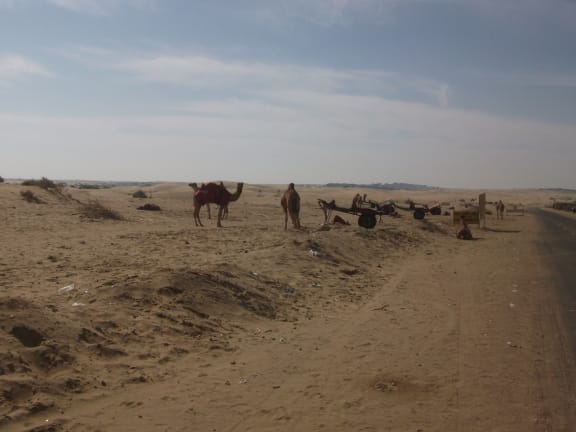
Thar Desert, Rajasthan Photo: Daniel Beban
Jaisalmer is an ancient city on the old trade route from the Middle East, through Afganistan to India and beyond. With the partition of India in 1947 the new border between Pakistan and India sliced the Thar Desert into two parts.
The centre of the old city of Jaisalmer is a sandstone fort that rises out of the desert like a giant sandcastle.
Built in the 12th century, it has changed little in almost 1000 years, with it’s maze of narrow alleys still home to local families. The rest of the city stretches out from the fort in a labyrinth of streets.
In 2013 I was based in Jaisalmer for a couple of months, helping UK film producer and artist Diana Mavroleon with sound recording for her documentary ‘The Sand of Music’. During that time we traveled to many villages in the surrounding desert (Kanoi, Dantal, Khiya, Bhoo and others) and recorded dozens of musicians of different musical castes.
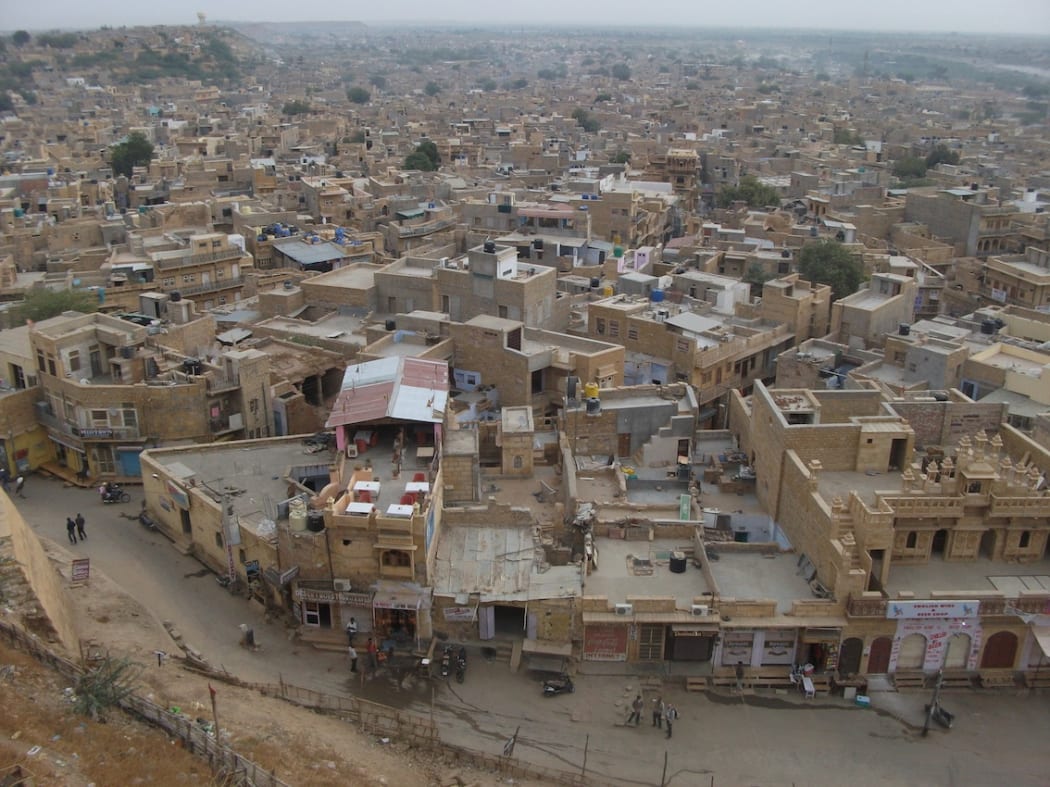
Jaisalmer Photo: Daniel Beban
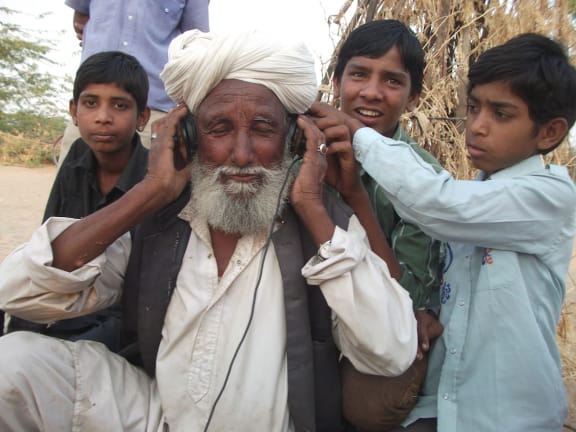
Hindal Khan listening to his recording Photo: Daniel Beban
Over many centuries the people of the desert have worked out systems to enable them to survive in the arid environment.
Water is a scarce resource, however, the knowledge of the desert people allows for a successful harvest of crops with just two small rainfalls each year.In most areas people must still travel considerable distances to the nearest well to fetch drinking water.
The people of the desert have evolved distinctive cultures, architecture and social systems adapted to the environment.
The traditional economy of the desert was based on animal husbandry, with nomadic grazing groups following their animals throughout the year. The herding of goats, cattle and sheep is still the basis of life in the desert region.
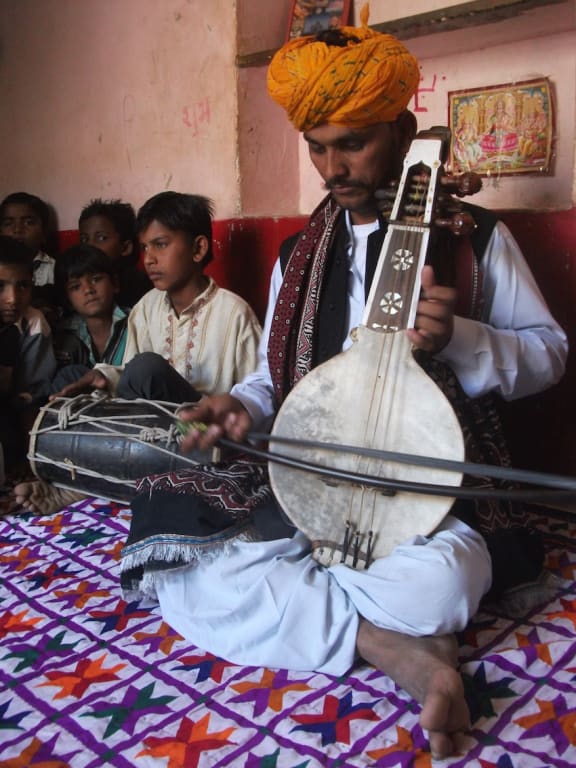
Nathu Khan (dholak) and Ghamsee Khan (kamaicha), Khiya Village Photo: Daniel Beban
It is a conservative area where where the caste system determines many aspects of a person’s life including who they can marry, where they live, and what occupation they will have.
There is a distinct hierarchy of castes in Rajasthan, with upper castes such as Brahmin and Rajput typically owning land, and many lower castes generally organized by occupation such as Dhobi (washers) and Lohar (blacksmiths).
And it is an area where the jajmani (patronage) system is still prevalent. This system has died out from most other areas of India, but the isolation and lack of opportunities in the desert has meant that in this region the jajmani system is still very much intact.
The system is very complicated in its details, but essentially it means that different castes perform social functions for other castes.
The musicians of the Thar Desert are able to survive within this harsh ecological environment and tightly knit social structure through the jajmani system.
The main two professional musician castes in the Thar Desert are Manganiyar and Langa. They are very similar: both are Muslim, they use the kamaicha as their primary instrument and they sing many of the same songs.
The main difference is that the Manganiyar perform almost exclusively for Hindu Rajput jajman (patrons), while the Langa’s jajman are predominantly Muslim.
In return for performing for their patron’s life-cycle rituals of births, weddings and deaths, the musicians receive gifts such as livestock, gold, clothes and money.
Manganiyar children learn music from their parents at a young age and perform alongside their elders.
Shanan Kahn of Kanoi village is one of the few remaining Manganiyars to play the swarmandal. He has seen dramatic changes in the desert during his lifetime including the construction of the Indira Ghandi Canal, which has brought water from the north to the desert.
The canal has allowed the irrigation of the desert for large-scale horticulture and even dairy farms.
While the canal has brought drinking water to many people in the desert, it has also caused environmental problems including soil erosion, water logging, and a rise in mosquito numbers bringing new diseases to the area.
The ‘green revolution’ of the desert has also brought about a major shift in the economy of the desert region, with multi-national companies and government buying large areas of land from traditional land owners.
Over the past 20 years land owners have been moving to the cities where there are more job opportunities. This is in turn affecting the ability of the musicians to survive off the traditional patronage system.
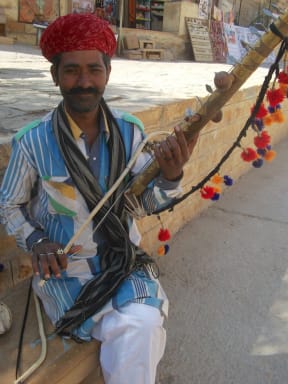
Harry Ram Bhopa, Jaisalmer Photo: Daniel Beban
Some musicians have been able to adapt to these changes, moving to the cities and performing for tourists in hotels in Jaisalmer and other centres, while a lucky few tour internationally, performing in festivals around the world. Others have picked up work in other occupations, such as laborers or truck drivers.
The government has set up artist colonies in several cities, to give musicians and other artists an urban base. The Kalakar Colony in Jaisalmer is home to many musicians.
Some of the world-touring Manganiyar musicians such as Khete Khan, have been able to secure good homes for their families here, while musicians of other castes such as Hari Ram, a Bhopa (folk priest) live in very difficult conditions just around the corner.
Taga Ram, a musician of the Bhil caste, has set up his own private enterprise on the outskirts of Jaisalmer, making algoza (double flute) and teaching music to tourists.
Somewhat surprisingly, even though the musicians and their patron families may live in different locations, their relationship through jajamani system still. The musicians continue to perform for the weddings of their traditional village patrons in Jaisalmer and other cities.
For the moment the bonds of the jajmani system are still strong in the Thar Desert region, but with the large scale economic and social change taking place in the region, only time will tell if this musical tradition will survive intact through future generations of musicians.
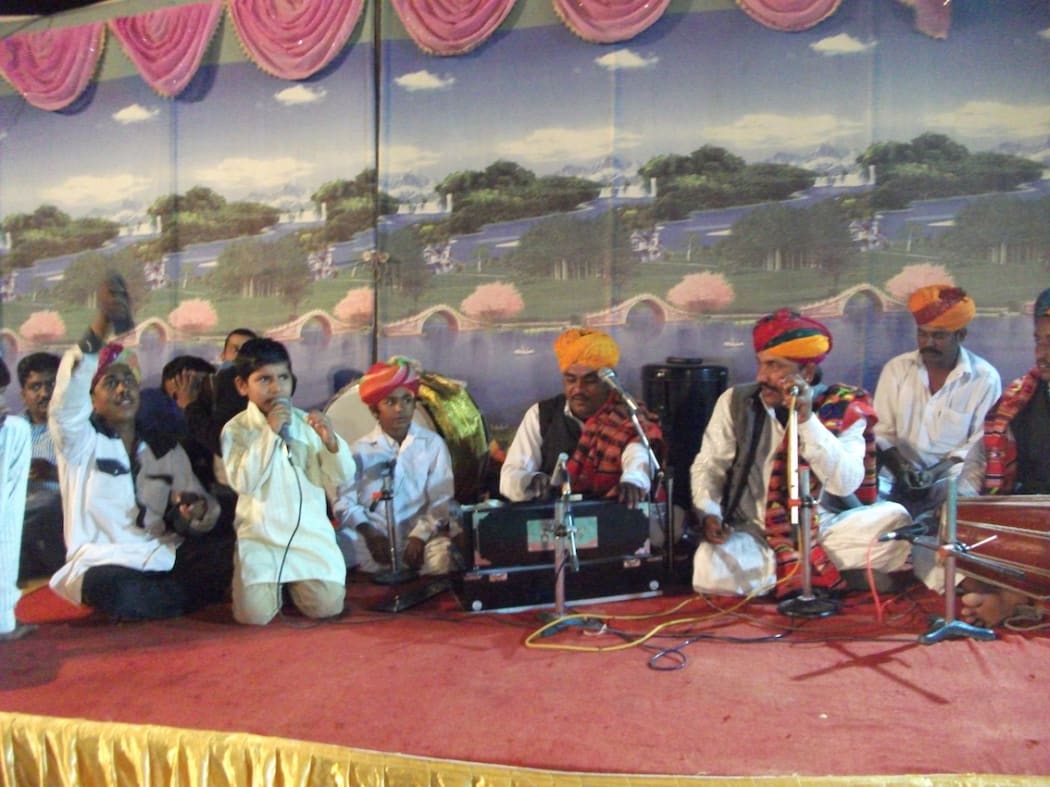
Manganiyar wedding band, Jaisalmer Photo: Daniel Beban
Many thanks to
Diana Mavroleon
Film producer/artist
London, UK
www.dianamavroleon.co.uk
Shubha Chaudhuri
Associate Director General (Academic)
Archives and Research Centre for Ethnomusicology
American Institute of Indian Studies
New Delhi
Imamddin Khan
Artistic Director
Ustadarba Music Institute
Jaisalmer
Dr Ram Singh Murthia
Retired scientist, ICR,
Jodhpur
Khete Khan Manganiyar
Hamira Village/Jaisalmer

